
Mastering Degrees of Adjectives and Adverbs: The Indispensable Role of Comparative and Superlative Printable Worksheets
In the intricate tapestry of the English language, adjectives and adverbs play a pivotal role in adding color, detail, and precision to our communication. They allow us to describe, qualify, and compare. However, simply knowing what an adjective or adverb is isn’t enough; true mastery comes from understanding how to use them to express varying degrees – comparing two things, or singling out one as the most or least of a group. This is where comparative and superlative forms come into play, and for learners and educators alike, the most effective tools for solidifying this knowledge are well-designed comparative and superlative printable worksheets.
The journey to fluent and accurate English usage often involves tackling specific grammatical structures that, while seemingly simple, can present nuanced challenges. Comparatives and superlatives fall squarely into this category. They are fundamental for expressing nuanced meaning, whether we are discussing which car is faster, who is the tallest in the class, or which book is more interesting than another. Without a firm grasp of these forms, communication can become clunky, imprecise, and even misleading.
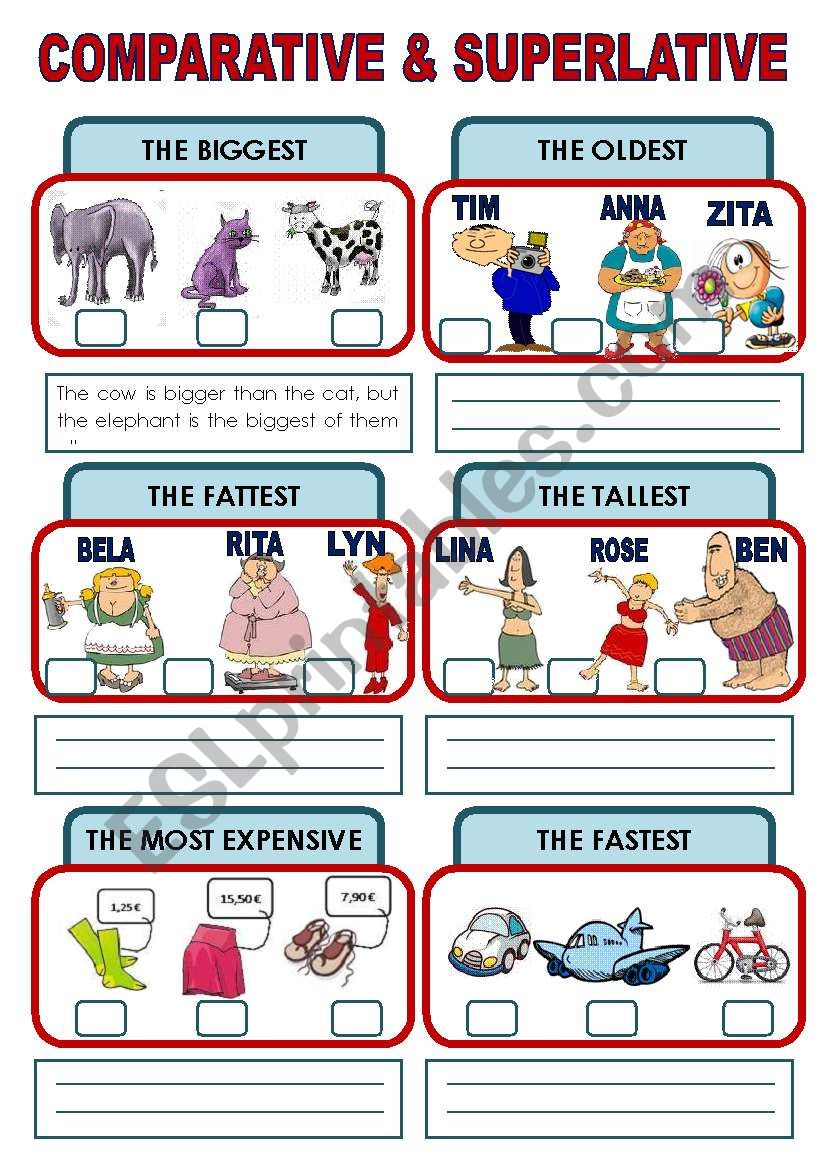
Understanding the Basics: Comparatives and Superlatives

Before delving into the utility of worksheets, let’s briefly recap the core concepts:

- Comparative Adjectives/Adverbs: Used to compare two people, places, things, or actions. They generally follow the pattern of adding "-er" to short adjectives/adverbs (e.g., tall -> taller, fast -> faster) or using "more" before longer ones (e.g., beautiful -> more beautiful, quickly -> more quickly).
- Superlative Adjectives/Adverbs: Used to compare three or more people, places, things, or actions, indicating which one possesses the quality to the highest or lowest degree. They typically involve adding "-est" to short adjectives/adverbs (e.g., tall -> tallest, fast -> fastest) or using "most" before longer ones (e.g., beautiful -> most beautiful, quickly -> most quickly).
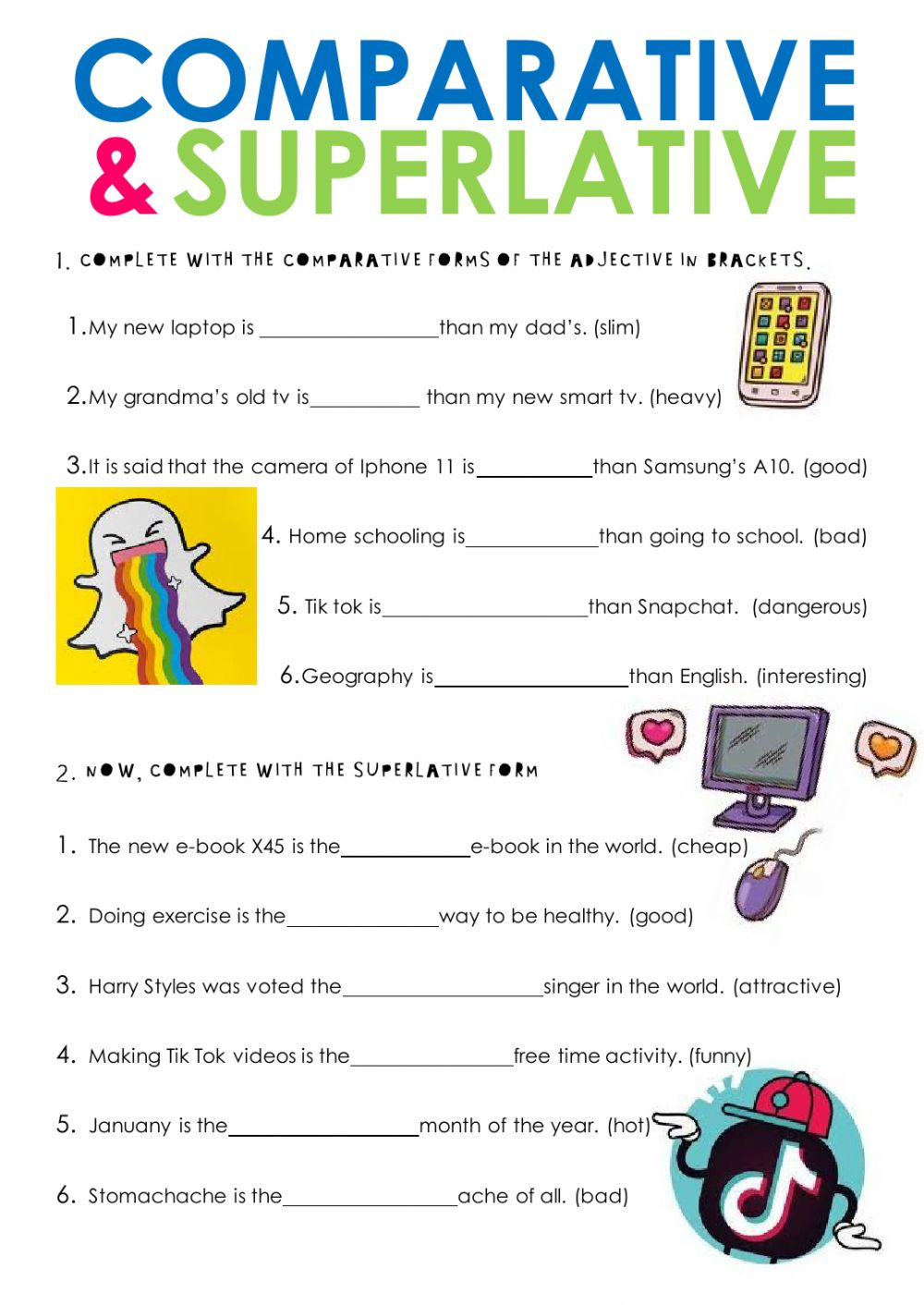
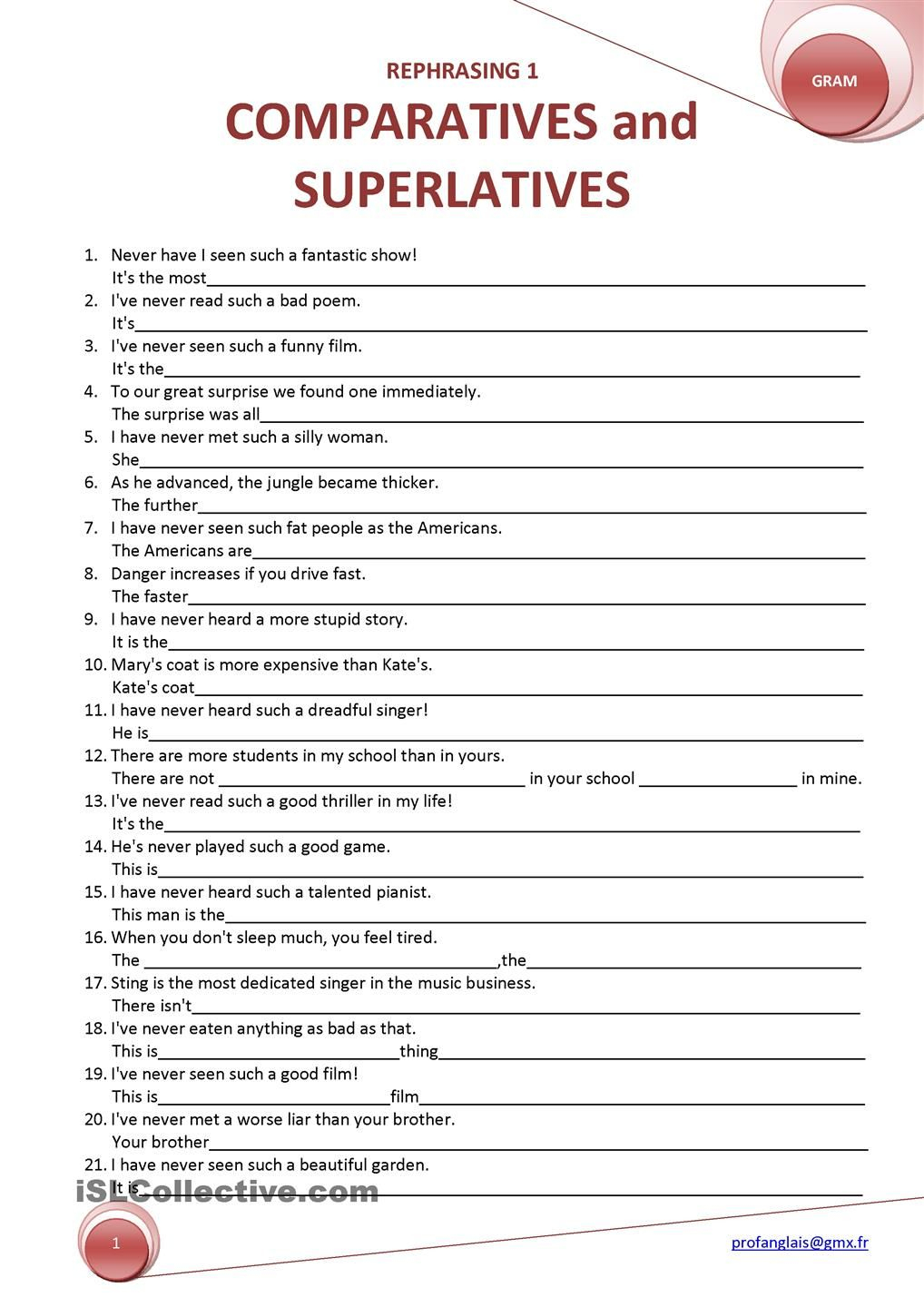
Beyond these regular forms, there are irregular adjectives and adverbs (e.g., good -> better -> best, bad -> worse -> worst, far -> farther/further -> farthest/furthest) that require memorization and dedicated practice.
The Learning Curve: Common Challenges
While the rules for regular comparatives and superlatives appear straightforward, learners frequently encounter difficulties:
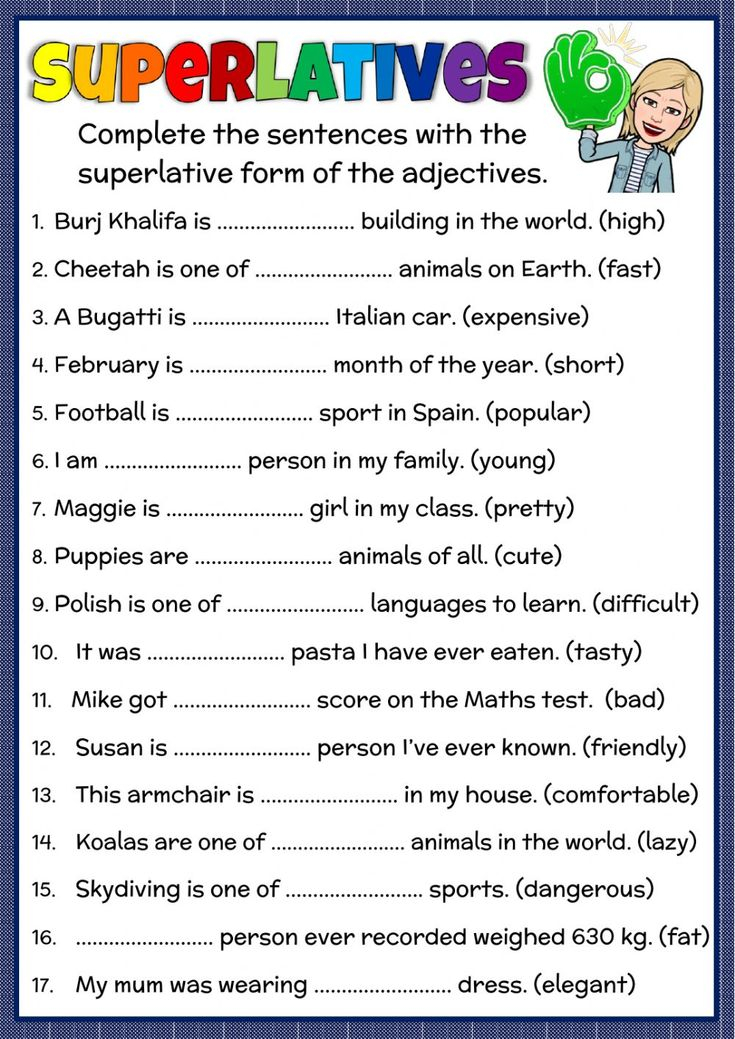
- Knowing When to Use "-er/-est" vs. "more/most": The syllable count rule is a common stumbling block, especially for adjectives ending in "-y" or those with ambiguous pronunciation.
- Spelling Changes: Adjectives like "big" (bigger, biggest), "hot" (hotter, hottest), "happy" (happier, happiest) require specific spelling adjustments that can be easily forgotten.
- Irregular Forms: These simply need to be learned by heart, and without consistent exposure and repetition, they remain a source of error.
- Avoiding Double Comparatives/Superlatives: A common mistake is saying "more better" or "most biggest."
- Contextual Usage: Deciding whether a comparative or superlative is appropriate based on the number of items being compared.
- Adjective vs. Adverb: Distinguishing when to use an adjective form (e.g., faster car) versus an adverb form (e.g., runs faster).


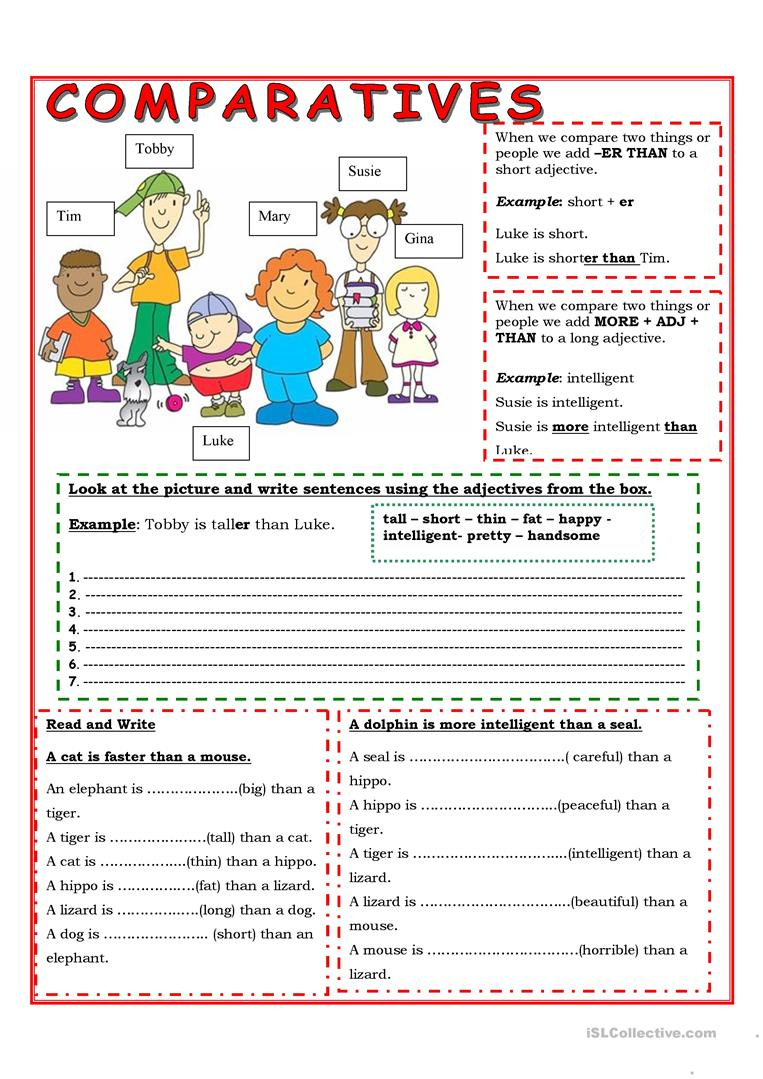
These challenges highlight the need for structured, repetitive, and engaging practice. This is precisely where comparative and superlative printable worksheets prove invaluable.
The Power of Comparative and Superlative Printable Worksheets
In an increasingly digital world, the tactile experience of working with pen and paper remains incredibly effective for language learning. Comparative and superlative printable worksheets offer a unique blend of benefits that digital exercises sometimes miss:
- Tangibility and Focus: Holding a worksheet and writing by hand can improve retention and reduce digital distractions, fostering a deeper engagement with the material.
- Accessibility: Once printed, these worksheets require no internet connection, no specific software, and no device, making them ideal for diverse learning environments, including classrooms with limited technology or home study.
- Repetition and Reinforcement: Worksheets are inherently designed for repeated practice, allowing learners to encounter the same rules and forms multiple times in varied contexts, solidifying their understanding.
- Customization and Differentiation: Educators can easily select, modify, or create worksheets tailored to specific student needs, learning styles, and proficiency levels, from beginner to advanced.
- Immediate Feedback (with Answer Keys): Many printable worksheets come with answer keys, enabling self-correction and immediate feedback, which is crucial for autonomous learning.
Diverse Types of Comparative and Superlative Printable Worksheets
The beauty of worksheets lies in their versatility. They can be designed to target specific aspects of comparative and superlative usage:
-
Basic Fill-in-the-Blanks: These are fundamental for introducing and reinforcing the basic rules. Learners are given a sentence with a blank and a base adjective/adverb, and they must fill in the correct comparative or superlative form.
- Example: My dog is _____ (big) than yours. -> bigger
- Example: She is the _____ (smart) student in the class. -> smartest
-
Sentence Transformation: This type encourages learners to actively manipulate sentences, applying the rules in a more complex way.
- Example: "John is tall. Mike is taller than John. Peter is the tallest." (Combine into one sentence using comparative and superlative forms).
-
Picture-Based Comparisons: Visual learners benefit immensely from worksheets that use images to prompt comparisons. Learners might compare the size of animals, the height of buildings, or the speed of vehicles, writing sentences using comparatives and superlatives.
- Example: (Picture of a small cat and a large dog) "The dog is _____ (large) than the cat."
-
Error Identification and Correction: This advanced exercise hones critical thinking skills. Learners are presented with sentences containing grammatical errors related to comparatives and superlatives and must identify and correct them.
- Example: "This is the most best movie I’ve ever seen." -> "This is the best movie I’ve ever seen."
-
Creative Writing Prompts: To encourage application in a more open-ended context, worksheets can provide prompts that require learners to use comparative and superlative forms in their own descriptive paragraphs or stories.
- Example: "Describe your ideal vacation spot, comparing it to places you’ve been and explaining why it’s the most appealing."
-
Matching Exercises: These can be used for irregular forms or for matching an adjective/adverb with its correct comparative/superlative pair.
- Example: Match ‘good’ with ‘better’ and ‘best’.
-
Comparison Charts/Tables: Learners can fill in tables with the base form, comparative, and superlative of various adjectives and adverbs, aiding in memorization, especially for irregular verbs.
-
Contextual Scenario Worksheets: These present mini-dialogues or short paragraphs where learners must choose the correct form based on the context and the number of items being compared.
Designing and Utilizing Effective Worksheets
For educators, creating or selecting effective comparative and superlative printable worksheets involves several considerations:
- Clarity of Instructions: Ensure the instructions are simple, concise, and easy for the target audience to understand.
- Gradual Progression: Start with simpler tasks (e.g., fill-in-the-blanks) and gradually introduce more complex ones (e.g., sentence transformation, error correction).
- Variety: Mix up the exercise types within a single worksheet or across a series of worksheets to maintain engagement and address different learning styles.
- Relevance: Where possible, make the content of the comparisons relevant to the learners’ experiences or interests.
- Inclusion of Irregulars: Dedicate specific sections or entire worksheets to the practice of irregular forms.
- Answer Keys: Always provide clear answer keys for self-assessment or easy grading.
In the classroom, worksheets can be used for:
- Pre-teaching: As a diagnostic tool to assess prior knowledge.
- In-class Practice: During lessons, allowing immediate feedback from the teacher.
- Homework Assignments: For independent reinforcement.
- Assessment: To gauge understanding after a unit.
- Remedial Work: For students who need extra practice on specific rules.
Benefits for Learners and Educators
For learners, working with comparative and superlative printable worksheets fosters:
- Active Learning: Writing physically engages them with the material.
- Confidence Building: Successful completion of exercises reinforces their understanding and builds self-assurance.
- Self-Paced Learning: They can work at their own speed, reviewing difficult concepts as needed.
- Immediate Feedback: With answer keys, they can instantly check their work and learn from mistakes.
For educators, these worksheets are a boon for:
- Time-Saving: Ready-made worksheets save preparation time.
- Customization: They can be easily adapted to suit specific class needs.
- Consistent Practice: Ensuring all students receive uniform exposure to the grammatical structures.
- Differentiated Instruction: Providing different levels of challenge to cater to mixed-ability classrooms.
Finding and Creating Your Own Resources
A wealth of comparative and superlative printable worksheets can be found online through educational resource platforms (like Teachers Pay Teachers), language learning blogs, and educational websites. Many sites also offer worksheet generators where you can input words and rules to create customized exercises. For those with a creative bent, designing your own worksheets allows for complete control over content, difficulty, and visual appeal, ensuring they perfectly align with your teaching objectives.
Conclusion
The ability to compare and contrast is fundamental to human thought and communication. In the English language, mastering comparative and superlative forms of adjectives and adverbs is non-negotiable for clarity and precision. While digital tools have their place, the enduring power of comparative and superlative printable worksheets cannot be overstated. They offer a tangible, accessible, and highly effective means of delivering the repetitive, focused practice necessary to embed these grammatical structures firmly in a learner’s linguistic repertoire. By strategically incorporating these versatile tools, educators can transform a potentially challenging area of grammar into an engaging and ultimately successful learning experience for their students.
